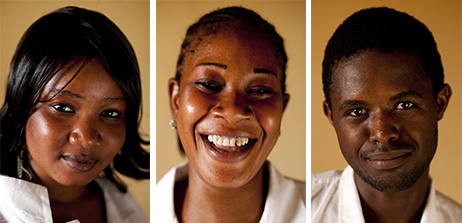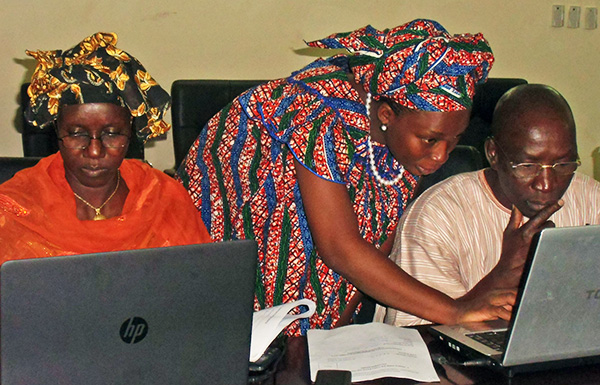
Mali Uses Health Workforce Data to Improve Access to Care for Those Most in Need
Like many countries, Mali doesn’t have enough health workers. Eighty-three of the world’s countries fall short of the World Health Organization’s minimum threshold of 23 health workers per 10,000 population.
“There is a need to ask the government to make much more of an effort to remedy the shortage of health workers,” said Mali’s current director of human resources for health, Dr. Idrissa Cissé. “But there is also the need to figure out if there isn’t a better manner to distribute the health workforce.” An equitable distribution of skilled health workers is vital for meeting the demand for family planning, ending preventable child and maternal deaths, and achieving an AIDS-free generation. Mali’s health workforce leaders need reliable data to inform evidence-based recruitment, deployment, and retention of health workers in the areas with the highest need.
An equitable distribution of skilled health workers is vital for meeting the demand for family planning, ending preventable child and maternal deaths, and achieving an AIDS-free generation. Mali’s health workforce leaders need reliable data to inform evidence-based recruitment, deployment, and retention of health workers in the areas with the highest need.
CapacityPlus partnered with the Directorate of Human Resources for Health (DHRH) at the Ministry of Health and Public Hygiene to implement a customized version of iHRIS Manage, part of the iHRIS platform of free and open source health workforce information systems tools and software.

The DHRH piloted iHRIS Manage in Sikasso District of Sikasso Region, including a census of health workers posted in public, private, and community-run health facilities as well as data entry, validation, and reporting. Reports and data visualizations helped to present the information in a clear manner for analysis.
Results showed that the district hospital and other urban sites had disproportionately more midwives than did health centers in rural areas (where 63% of the population lives), and that no primary health center was fully staffed according to national staffing norms. Taking quick action, the region implemented a rotation system where midwives work one week each month in a rural health center to mentor lower-level auxiliary midwives and provide access to long-acting contraceptive methods. Sikasso Region went on to recruit and post 26 additional midwives and obstetric nurses in rural sites.
After the pilot, the DHRH began expanding iHRIS to cover the rest of the districts of Sikasso Region and the other eight regions of the country, including Bamako. The national-level rollout of iHRIS is almost complete. Currently 14,114 health worker records are included in iHRIS. The ongoing process of decentralization of iHRIS to the regional level will enable local leaders and managers to make evidence-based decisions on recruitment, deployment, and retention using up-to-date information—to ensure that disadvantaged populations have access to high-quality health care. Leaders and managers at the national level have already started to use iHRIS data to improve management and deployment decisions, track international commitments, and advocate for more health workers. Just a few examples:
Management and deployment
- After many health workers fled from the north during the conflict in 2012–13, the DHRH identified those who had been posted in Gao Region and their telephone numbers, enabling the government to offer them grants to return. This action provided much-needed care for the conflict-affected populations.
- For the opening of a large health center in Bamako’s Kablaban Coura neighborhood, the DHRH used iHRIS to select 26 qualified and experienced providers who could be transferred to supervise the new staff.
- This month the DHRH is using iHRIS data to guide the deployment of 185 newly recruited, public-sector health workers (40 doctors, 60 midwives, and 85 high-level nurses [techniciens superior de santé]) to the regions.
Tracking international commitments
- The DHRH submits the total numbers of health workers in the three northern regions of Mali (Tombouctou, Kidal, and Gao) to the Ministry of Public Health every quarter using iHRIS data and on-the-ground information in order to track Mali’s progress in honoring commitments made at the high-level Donor Conference for Development in Mali held in Brussels in 2013.
Advocacy
- In 2014, the DHRH presented preliminary iHRIS results to the prime minister’s special advisor for health, who then reported the findings to the prime minister. The prime minister recommended an increase in recruitment for 2015.*
Mali’s implementation of iHRIS Manage is providing leaders and decision-makers with timely and accurate information about the distribution of health workers and projected needs for more workers due to transfers and retirements. By strengthening the health system, this initiative is contributing to the goal of improving health outcomes and moving toward the country’s vision of high-quality health care for all.
* The prime minister has since been replaced.
Help CapacityPlus spread the word about strengthening the health workforce. Follow us on Twitter and like us on Facebook.
Related items:
Photo 1 by Trevor Snapp, courtesy of IntraHealth International (health workers in Mali). Photo 2 by Kayode Odusote (iHRIS training in Mali, January 2014)


